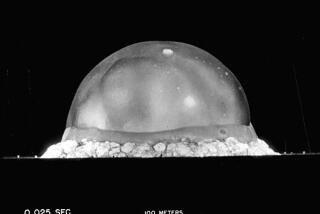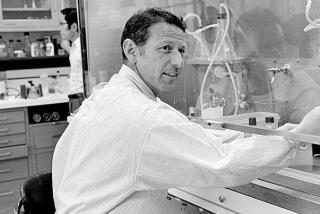Henry Kendall; Nobel Prize-Winning Nuclear Scientist
- Share via
Henry W. Kendall, Nobel Prize-winning nuclear and atomic physicist best known for his role as co-founder and longtime chairman of the 100,000-member Union of Concerned Scientists that champions environmental protection, has died. He was 72.
Kendall died Monday during an underwater photography dive at Wakulla Springs State Park near Tallahassee, Fla. An autopsy was planned to determine whether he died of a heart attack or accidental drowning. Colleagues said he was an experienced diver and still had air in his scuba tank.
A professor at the Massachusetts Institute of Technology, Kendall shared the Nobel Prize in 1990 for what the Swedish Academy of Sciences described as “long and rather boring experimental work” that led to proof of the existence of subatomic particles called quarks.
Starting in the late 1960s, Kendall worked with Jerome I. Friedman of MIT and Canadian Richard E. Taylor of Stanford University to uncover evidence that protons and neutrons, once thought to be the basic building blocks of matter, were made up of smaller components called quarks. Their efforts earned them the $700,000 prize.
Before that proof, the quark theory had existed only as a mathematical model.
“His work was seminal to the great developments in physics in the last 50 years,” said UCLA theoretical physicist Nina Byers, a long-time colleague of Kendall, after learning of his death. “I can’t emphasize just how important his discovery of quarks was.”
“These things wrench people’s lives out of shape,” Kendall told The Times after the announcement of the prize, which he said he had not anticipated.
He said at that time that he intended to devote even more of his time to scientific issues that could have profound sociological and environmental impacts. The Nobel fame, he said, would only enhance his efforts to explore and warn of the darker sides of science, including global warming and the greenhouse effect, as well as the hazards associated with creating nuclear power and disposing of nuclear waste.
“I am very deeply concerned,” he said, “about the effects of science and technology in misapplication and damage that it does.”
Kendall helped establish the Cambridge, Mass.-based Union of Concerned Scientists in 1969, which was originally dedicated to opposing nuclear weapons and nuclear power plants. He became chairman of the organization in 1973 and remained in that position until his death.
When the California Legislature was considering building more nuclear reactors to fuel public utilities, Kendall appeared before the Subcommittee on State Electrical Energy Policy in Sacramento to criticize safety policies of the national Atomic Energy Commission.
In hearings in the California Capitol and in Washington, D.C., Kendall asserted that the commission had suppressed reactor safety problems, distorted and censored safety data developed by its staff, and ignored the doubts of its own experts. The agency’s behavior, he testified, had “generated suspicion and a great deal of bad feeling” within the scientific community.
Kendall’s colleagues came to accept him as a combatant in the nuclear arena.
“People sensed the correctness of it,” he told The Times in 1990. “And any lingering doubts were put to rest at Three Mile Island.”
Kendall also led his organization’s opposition to President Ronald Reagan’s Strategic Defense Initiative, the so-called Star Wars system that would have developed satellites to defend U.S. cities against nuclear attack.
But as the Cold War and the threat of nuclear annihilation, and even the use of nuclear power, receded, Kendall turned the scientific union’s efforts toward problems of overpopulation, pollution and global warming.
In 1993 he drafted a “World Scientists’ Warning to Humanity” about burgeoning population growth and environmental degradation, and persuaded about 1,500 experts to sign it. Kendall garnered signatures from 104 Nobel Prize winners and the heads of scientific societies from London to Beijing.
The tall, handsome and silver-haired Kendall relished his reputation as the scientific world’s prophet of gloom. He counted on his reputation as a rational, accomplished scientist to dissipate skepticism by presenting careful data on population increases, deforestation, water shortages and reduction of per-capita food production.
“The bulk of the misery will be visited upon the Third World. It will occur brutally,” Kendall typically told a Princeton assemblage in 1993. “In the United States, we think these problems affect people living far away in breechcloths. [But] if we wait until we see the damage here, it will be too late.”
Although he stopped short of advocating restrictions on immigration, Kendall cited Haiti and Mexico as examples of countries already suffering from burgeoning populations and the ruination of environmental resources.
Instead of immigration curbs, he advocated combating the threats with economic development, education, conservation and pollution-reducing technology.
Kendall advised President Clinton on global warming, and in 1992 spoke frequently at hearings on an international global warming treaty. He advocated reducing carbon dioxide emissions 60% by 2025 “to lower the risk of unacceptable damage to natural ecosystems and humanity.”
He also had a lighter side, as he demonstrated in 1991 when he and other MIT and Harvard Nobel laureates concocted the ersatz Ignatius Nobel prizes. Those awards were designed for people overlooked for prizes named for Ig’s distant cousin Alfred Nobel, inventor of TNT.
The Ig Nobel was awarded to then Vice President Dan Quayle as a “consumer of time and occupier of space, for demonstrating better than anyone the need for science education.” Michael Milkin, then in prison, received the Ig Nobel as “father of the junk bond, to whom we are all indebted,” and Edward Teller, father of the hydrogen bomb, received the Ig Nobel for peace “for his lifelong efforts to change the meaning of peace as we know it.”
A native of Boston, Kendall was a graduate of Amherst College and earned his PhD in nuclear and atomic physics from MIT. He taught and performed research at Stanford University’s High Energy Laboratory from 1956 to 1961, when he joined the MIT faculty.
He was a large shareholder in his family business, Kendall Co., which made Curad bandages, Curity diapers and hospital equipment until it was bought by Colgate Palmolive Co. in 1972.
Kendall is survived by a brother, John, of Sharon, Mass.






